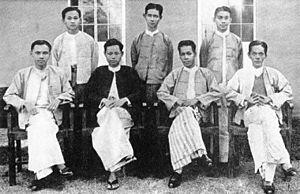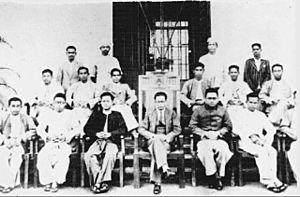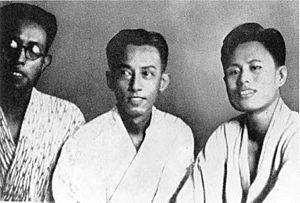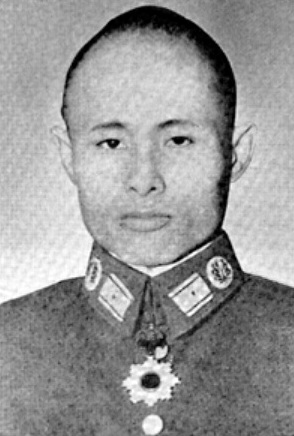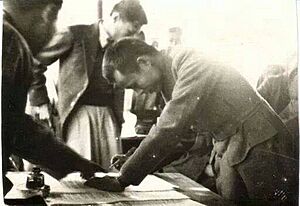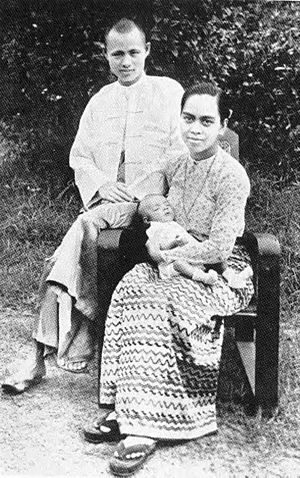Aung San facts for kids
Quick facts for kids
Aung San
|
|
|---|---|
|
အောင်ဆန်း
|
|
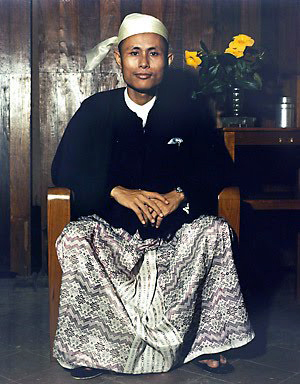 |
|
| Premier of British Crown Colony of Burma | |
| In office 26 September 1946 – 19 July 1947 |
|
| Preceded by | Sir Paw Tun |
| Succeeded by | Office abolished U Nu as Prime Minister |
| Deputy Prime Minister and Minister of War of the State of Burma | |
| In office 1 August 1943 – 27 March 1945 |
|
| Preceded by | Office created |
| Succeeded by | Office abolished |
| President of the Anti-Fascist People's Freedom League | |
| In office 27 March 1945 – 19 July 1947 |
|
| Preceded by | Office created |
| Succeeded by | U Nu |
| General Secretary of Communist Party of Burma | |
| In office 15 August 1939 – 1940 |
|
| Preceded by | Office created |
| Succeeded by | Thakin Soe |
| Personal details | |
| Born |
Htein Lin
13 February 1915 Natmauk, Magwe, British Raj |
| Died | July 19, 1947 (aged 32) Rangoon, British Burma |
| Cause of death | Assassination |
| Resting place | Martyrs' Mausoleum, Myanmar |
| Nationality | Myanmar |
| Political party | Anti-Fascist People's Freedom League Communist Party of Burma Burma Socialist Party Thakin Society |
| Spouse |
Khin Kyi
(m. 1942) |
| Children | Aung San Oo Aung San Lin Aung San Suu Kyi Aung San Chit |
| Parents | U Phar (father) Daw Su (mother) |
| Relatives | Ba Win (brother) Sein Win (nephew) Alexander Aris (grandson) Kim Aris (grandson) |
| Alma mater | Rangoon University Yenangyaung High School |
| Occupation | Politician, soldier |
| Known for | Father of the Nation of modern-day Myanmar, Founder of the Myanmar Armed Forces and Founder of All Burma Student Union (later known as All Burma Federation of Student Unions) |
| Signature | |
| Military service | |
| Allegiance | Burma Independence Army Burma National Army Imperial Japanese Army |
| Rank | Major general (highest rank in military at that time) |
Aung San (Burmese: ဗိုလ်ချုပ် အောင်ဆန်း; MLCTS: aung hcan:, pronounced: [àʊɰ̃ sʰáɰ̃]; 13 February 1915 – 19 July 1947) was a very important Burmese politician and revolutionary. He played a huge role in Myanmar's fight to become free from British rule. Sadly, he was killed just six months before Myanmar gained its independence.
Aung San is known as the founder of modern-day Myanmar. He also started the Tatmadaw, which is the country's armed forces. People often call him the "Father of the Nation" or "Father of Independence."
He really wanted to end British rule in Burma. Aung San started or was part of many political groups and movements. He always believed in fighting against foreign control. As a student, he studied socialism, which is a way of organizing society. In his first year at university, he was chosen to be on the student union's committee. He also edited their newspaper.
Later, he joined the Thakin Society and became its general secretary. He helped create the Communist Party of Burma in 1939. But he left it soon after because he disagreed with the other leaders. After that, he helped start the People's Revolutionary Party. This party later became the Burma Socialist Party. Their main goal was to make Burma independent from the British.
Before World War II started, Aung San left Burma. He went to China to find help for Burma's independence. During the time Japan controlled Burma, he was the minister of war. This was in the Japan-backed State of Burma, led by Dr. Ba Maw. When Japan started losing the war, Aung San changed sides. He joined his forces with the Allies to fight against the Japanese.
After World War II, he worked to get Burma's independence from Britain. He signed an agreement called the Aung San-Attlee agreement. He was the 5th Premier of the British Crown Colony of Burma from 1946 to 1947. His party, the Anti-Fascist People's Freedom League, won the 1947 Burmese general election. But he and most of his cabinet were killed shortly before the country became independent.
Aung San's daughter, Aung San Suu Kyi, is also a famous politician. She won the Nobel Peace Prize. She was Burma's State Counsellor and its first female Minister of Foreign Affairs.
Contents
Early Life and School Days
Aung San was born in Natmauk, Magway District, on February 13, 1915. This was during the time of British rule in Burma. His family was considered middle-class. He was the youngest of nine children, with three older sisters and five older brothers. His brother, Aung Than, gave him the name Aung San.
Aung San first went to a Buddhist monastic school in Natmauk. When he was in grade 4, he moved to Yenangyaung. This was because his oldest brother, Ba Win, became the principal of the high school there.
When he was young, Aung San didn't talk much before he was eight years old. As a teenager, he often spent hours reading and thinking by himself. He didn't pay much attention to his clothes or how he looked. In his early writings, he disagreed with the idea of Western-style individualism. He preferred a social idea based on "standardizing human life." Later, Aung San became friends with U Thant through their shared friend, U Nu.
University Years and Student Strikes
Aung San started attending Rangoon University in 1933. He quickly became a leader among the students. He was chosen to be on the executive committee of the Rangoon University Students' Union (RUSU). Then, he became the editor of the RUSU's magazine, Oway (Peacock's Call). Other students at the time said he was very inspiring and deeply interested in politics.
In February 1936, he and U Nu were kicked out of the university. This happened because they refused to say who wrote an article in the student newspaper. The article, called "Hell Hound at Large," criticized a senior university official. Their expulsion led to the Second University Students' Strike, which lasted for three months. After the strike, the university let Aung San and Nu come back.
The events of 1936 greatly affected Aung San's future. Before 1936, not many people knew him outside of Rangoon University. But during the student strike, his name and picture were in daily newspapers. He became known across the country as a nationalist leader and student activist. He also took on his first student leadership roles. He was secretary of the student boycott council. He also represented students on the government's University Act Amendment Committee. This committee was formed because of the strike. Later in 1936, after the strike, he was elected vice president of the Rangoon University Student Union. Because he was part of the strike, he couldn't take his exams in 1936. He received his Bachelor of Arts degree in 1937.
After graduating, Aung San started studying for a law degree. At that time, he wanted to try for the Indian Civil Service exams and go into politics. In 1937, he and other student leaders founded the All Burma Student Union. It was later known as the All Burma Federation of Student Unions. He was elected general secretary of this union. In 1938, he became president of both the All Burma Student Union and the Rangoon University Student Union. But these duties took up too much time for him to study. He failed his exams in 1938. After 1938, he decided to stop pursuing a regular career. He committed himself fully to revolutionary politics.
Becoming a Revolutionary Leader
In October 1938, Aung San left his law classes and entered national politics. At this point, he was strongly against British rule and any form of foreign control. He became a Thakin (meaning "lord" or "master"). This title was used by Burmese people to show they were the true masters of their country. He joined the Dobama Asiayone ("We Burmans Association"). He was its general secretary until August 1940. In this role, he helped organize many strikes across the country. These strikes became known as the ME 1300 Revolution. This name came from the Burmese calendar year 1300, which was between August 1938 and July 1939 in the Western calendar.
On January 18, 1939, the Dobama Asiayone announced they would use force to overthrow the government. This led the authorities to crack down on the organization. On January 23, police raided their headquarters at Shwedagon Pagoda. They arrested Aung San and held him in prison for fifteen days. He was accused of planning to overthrow the government, but these charges were dropped. After he was released, Aung San suggested a plan to gain Burmese independence. This plan included countrywide strikes, refusing to pay taxes, and using guerrilla warfare.
In August 1939, Aung San helped found the Communist Party of Burma (CPB) and became its first Secretary General. Aung San later said his relationship with the CPB was difficult. He joined and left the party twice. Soon after founding the CPB, Aung San started a similar group. It was called either the "People's Revolutionary Party" or the "Burma Revolutionary Party." This party followed Marxism, a political idea. Its goal was to support Burmese independence from the British. This party continued and was reformed into the Burma Socialist Party after World War II.
Aung San was not paid for most of his work as a student or political leader. He lived in poverty for much of this time. His friends and colleagues recognized his strong work ethic and good organizing skills. However, they sometimes criticized him for not being good at public relations or for seeming arrogant.
World War II and the Fight for Freedom
When World War II began in September 1939, Aung San helped create another nationalist group called the Freedom Bloc. This group brought together the Dobama, the All Burma Students Union, active monks, and Dr. Ba Maw's Poor Man's Party. Dr. Ba Maw was the leader of the Freedom Bloc, and Aung San was its general secretary. Their goal was to use the war as a chance to gain Burma's independence. This group was similar to the Indian revolutionary group "Forward Bloc." Their leader, Subhas Chandra Bose, often talked with Ba Maw. In 1939, Aung San was briefly arrested for planning to overthrow the government by force. He was released after seventeen days. After his release, Aung San suggested a plan to gain Burmese independence. This plan included countrywide strikes, refusing to pay taxes, and using guerrilla warfare.
In March 1940, he went to a meeting of the Indian National Congress in Ramgarh, India. Other Thakins, like Than Tun and Ba Hein, went with him. There, Aung San met many leaders of India's independence movement. These included Jawaharlal Nehru, Mahatma Gandhi, and Subhas Chandra Bose. When Aung San returned to Burma, he found that the Burmese government had issued a warrant for his arrest. Many other leaders of the Thakins and the Freedom Bloc were also wanted. This was because these groups were trying to start a revolution against the British, partly with Japanese support.
Besides these warrants, a district official named "Xavier" offered a reward of 500 rupees to anyone who could capture Aung San. Some of Aung San's friends told him to go to Shanghai International Settlement and meet with communist agents there. But he was in a hurry to leave and couldn't find a ship going to that city. On August 14, 1939, Aung San and another Thakin friend, Hla Myaing, boarded a Norwegian cargo ship called Hai Lee to Xiamen, China. Neither Aung San nor Hla Myaing used their real names. They called themselves "Tan Luang Shun" and "Tan Su Taung." They wandered the city for several weeks without a clear plan and with little money. Then, Japanese secret police found them. They convinced Aung San and Hla Myaing to go to Japan instead. The two left for Tokyo, stopping in Taiwan, and arrived in Japan on September 27, 1940.
The Thirty Comrades
In May 1940, Japanese intelligence officers, led by Suzuki Keiji, arrived in Yangon. They pretended to be journalists. Their real goal was to gather information and get local groups to help with Japan's planned invasion of Burma. They had an office at 40 Judah Ezekiel Street. They made strong connections with the Thakins, and Aung San was a main member. Because Japanese intelligence knew about important political figures in Burma, they were aware of Aung San's activities by the time he arrived in Japanese-controlled China.
Aung San spent the rest of 1940 in Tokyo. He learned the Japanese language and their political ideas. At that time, he wrote that he was against Western individualism. He wanted to create a strong government like Japan's, with "one state, one party, [and] one leader." While in Japan, he wore a Japanese Kimono and used a Japanese name, "Omoda Monji." During this time, a plan called the Blue Print for a Free Burma was written. People believe Aung San wrote it, but some disagree.
In February 1941, Aung San worked with Japanese intelligence. He left Hla Myaing in Bangkok and secretly went back into Burma. He started trying to find and recruit more Burmese agents to work with the Japanese. He entered the country secretly through the port of Bassein. He changed into a longyi, a traditional Burmese garment, and took a train to Rangoon using a fake name. Within weeks, he had recruited thirty of his old revolutionary friends. He smuggled them out of the country using Japanese intelligence networks. These "Thirty Comrades" were taken to the Japanese-controlled island of Hainan for more training. Aung San was twenty-five, the third-oldest in the group. While training on Hainan, all thirty men took new names starting with "Bo," meaning "officer." This had become a title used by Westerners in Burma. Aung San took the name "Bo Teza" ("Teza" means "fire"). The Thirty Comrades trained for six months on Hainan with Suzuki Keiji and other Japanese officers. Aung San, Ne Win, and Setkya received special training. The Japanese planned to give them important positions in the Burmese government after they conquered the territory.
Fighting for Independence
Between November and December 1941, Aung San and his group successfully recruited about 3,500 Burmese volunteers. These volunteers came from the Siam-Burma border to join their army. On December 28, 1941, Aung San and the other Thirty Comrades officially started the Burma Independence Army in Bangkok. Three days later, the BIA entered Burma behind the invading Japanese Fifteenth Army. The BIA let the Japanese Army do most of the fighting. But they occupied the areas behind Japanese lines after the British had left. When BIA units arrived in many parts of Burma, there was more violence between different groups. This was especially against Karen people and others who had special positions under British rule. The violence lasted for several weeks until the Japanese Army stepped in.
The capital of Burma, Rangoon, fell to the Japanese in March 1942. This was part of the Burma Campaign. The BIA formed a government for the country under Thakin Tun Oke. This government worked alongside the Japanese military administration until the Japanese ended it. In July, the BIA was reformed as the Burma Defense Army (BDA). Aung San was made a colonel and put in charge of this force. He was later invited back to Japan. Emperor Hirohito gave him the Order of the Rising Sun, a special award.
On August 1, 1943, the Japanese held an independence ceremony in Rangoon. They formally granted Burma independence. But it was on the condition that Burma would be under a wartime government for the rest of the war. Burma also had to declare war on the Allies. The Japanese had planned to make Aung San the leader of the country. But in the end, they were more impressed with Dr. Ba Maw. They made him the leader instead, giving him almost total control under their direction. Aung San became the second most powerful person in the government. The government was set up like Japan's. It purposely avoided democratic ideas and ways of governing. The army, still led by Aung San, adopted their motto at this time: "One Blood, One Voice, One Command." This is still the official motto of the Burmese military.
As the war turned against Japan, Aung San became more doubtful that Japan could win. He started planning an uprising against the Japanese in Burma. He secretly formed the "Anti-Fascist People's Freedom League" in August 1944. He organized a secret meeting in Bago. This meeting included the Burma National Army, the Communist Party of Burma, and the People's Revolutionary Party. After this meeting, Aung San's forces began secretly storing supplies. They were getting ready to fight against the Japanese. In late March 1945, as Allied forces moved towards Rangoon, Aung San led the BNA in a parade. This was in front of Government House in Rangoon. After the parade, the Japanese sent them to the front lines. A few days later, on March 27, the BNA switched sides and attacked the Japanese instead. March 27 became known as Resistance Day. Later, the military government renamed it "Tatmadaw (Armed Forces) Day."
After the Burmese army attacked the Japanese, it was renamed the "Patriotic Burmese Forces." Its command was split into eight different regions. Aung San was given command of the first region. This included the areas of Prome, Henzada, Tharrawaddy, and Insein. His political advisor was Thakin Ba Hein, a Communist Party leader. On March 30, the Allied commander in Southeast Asia, Louis Montbatten, officially recognized the Burmese army as "an Allied force."
The Burmese National Army continued to bother the Japanese throughout the rest of the war. When Allied forces took back Rangoon on May 2, 1945, the BNA was symbolically sent into the city two days before any other soldiers. The Allies helped arm Aung San's forces somewhat after they switched sides. They gave the BNA 3,000 small weapons.
Aung San first met with General Bill Slim on May 16, 1945. He appeared unexpectedly in Slim's camp, wearing the uniform of a Japanese major general. At the meeting, Aung San said he intended to ally with the British until the Japanese were driven out of Burma. He agreed to combine his forces with Slim's British-led army. When Slim asked Aung San if he was taking a risk by coming to his camp in a Japanese uniform and acting boldly, Aung San replied, "No, because you are a British officer." Slim later wrote that Aung San made a good impression in the meeting.
After the War: Leading to Independence
World War II ended on September 12, 1945. After the war, the Burma National Army was renamed the Patriotic Burmese Forces (PBF). The British then slowly disarmed them as the Japanese were pushed out of different parts of the country.
The leaders of the Patriotic Burmese Forces were offered positions in the Burma Army under British command. This was part of an agreement made at the Kandy conference with Lord Louis Mountbatten in Ceylon in September 1945. Aung San was not invited to negotiate. This was because the British Governor General, Sir Reginald Dorman-Smith, was thinking about putting him on trial. This was for his role in the public execution of a Muslim headman during the war. The new Burmese army would have 5,000 of Aung San's Japanese-trained Bamar soldiers. It would also have 5,000 British-trained soldiers, mostly Chin, Kachin, or Karen. Aung San wrote to U Seinda in Arakan, saying he supported U Seida's fight against the British. But he would cooperate with them for strategic reasons. After the Kandy Conference, he reorganized his formally disbanded soldiers. He formed a group called the People's Volunteer Organization (PVO). They continued to wear uniforms and train in public. The PVO was loyal to Aung San and his party, not the government. By 1947, the PVO had over 100,000 members. In January 1946, a victory festival was held in Myitkyina, the Kachin capital. Governor Dorman-Smith was invited, but Aung San and his party were not. This was because of "their connection with the Burma Independence Army."
In a bold move, Aung San turned himself in for the execution of a village headman. Arresting him would have caused a nationwide armed rebellion by the PVO. So, Dorman-Smith was replaced by a new Governor General of Burma, Sir Hubert Rance. Rance agreed to recognize and negotiate directly with Aung San. This was possibly to keep both of them separate from the Communist Party of Burma. He also agreed to appoint Aung San as a counselor for defense on the Executive Council. This was a temporary cabinet formed before the upcoming Burmese national election. On September 28, 1946, Aung San was given an even higher position: deputy chairman. This made him effectively the 5th Prime Minister of the British-Burma Crown Colony. Aung San had first worked closely with the Communist Party of Burma. But after they started criticizing him for working with the British, he banned all communists from his Anti-Fascist People's Freedom League on November 3, 1946.
Agreements for a New Nation
Aung San was basically the Prime Minister, but the British still had the power to veto his decisions. British Prime Minister Clement Attlee invited Aung San to London in 1947. They were to discuss the terms for Burma's independence. At a press conference in Delhi, on his way to London, Aung San said that the Burmese wanted "complete independence." He said they were ready for "a violent or non-violent struggle or both" to achieve it. He hoped for the best but was prepared for the worst. He arrived in Britain by air in January 1947 with his deputy Tin Tut.
Attlee and Aung San signed their agreement on Burma's independence on January 27. After the Burmese election in 1947, Burma would join the British Commonwealth (like Canada and Australia). However, its government would have the option to leave. Its government would control the Burmese Army once Allied armies left. A new constitution would be written as soon as possible. This constitution would be presented to the British parliament quickly. Britain would also support Burma joining the newly formed United Nations. The agreement was not fully supported. Two other delegates, U Saw and Thakin Ba Sein, refused to sign it. It was also criticized in Burma by Aung San's opponents. No delegates representing Burma's ethnic minorities were present. Both Karen and Shan leaders sent messages. They warned that they would not consider any agreement signed at the conference binding for their communities.
Two weeks after signing the agreement with Britain, Aung San signed another agreement. This was at the second Panglong Conference on February 12, 1947. He signed it with leaders representing the Shan, Kachin, and Chin peoples. In this agreement, these leaders agreed to join a united independent Burma. This was on the condition that they would have "full autonomy." They would also have the right to leave in 1958, after ten years. Karen leaders were not included in this agreement. They hoped for a separate Karen State within the British Empire. The date of the Panglong Agreement signing is celebrated in Burma as "Union Day." However, Ne Win effectively ended any agreement with Burma's minority communities after his coup in 1962.
The 1947 Burmese general election held in April 1947 was not perfect. The Karens, Mon, and most of Aung San's other political opponents boycotted the election. Since they ran almost unopposed, every delegate in Aung San's party was elected. In the end, Aung San's AFPFL won 176 out of 210 seats in the Constituent Assembly. The Karens won 24, the Communists 6, and the Anglo-Burmans 4. In July, Aung San held a series of meetings at Sorrenta Villa in Rangoon. They discussed how to rebuild Burma.
After the 1947 election, Aung San began to form his own cabinet. Besides ethnic Burmese statesmen like himself and Tin Tut, he also convinced others to join. These included the Karen leader Mahn Ba Khaing, the Shan chief Sao Hsam Htun, and the Bamar leader U Razak (who was of Tamil ancestry). No Communists were invited to join.
A Tragic End
On July 19, 1947, a little after 10:30 AM, a jeep with gunmen in military clothes drove into the courtyard of the Secretariat Building. Aung San was having a meeting with his new cabinet there. There was no wall or gate protecting the government building. Even though Aung San had been warned about a plot to kill him, the guards did not stop the car. Four men from the car ran up the stairs towards the council chamber. They shot the guard outside and burst into the room. Only three people in the room survived.
Besides Aung San, eight other people were killed. Seven of them were also politicians. Thakin Mya was a minister who had been a student leader and a close friend of Aung San. Ba Choe, the minister of information, had been the editor of a well-known nationalist newspaper. Abdul Razak, a Tamil Muslim, was the minister of education and a headmaster. Ba Win, the minister of trade, was Aung San's older brother. Mahn Ba Khaing, the minister of industry, was one of the few Karen politicians who joined the new government. Sao Sam Htun, the minister of the Hill Regions, was a Shan prince. He had actively helped convince other ethnic minorities to join independent Burma. Ohn Maung was a deputy minister in the transportation ministry. He had just entered the room to give a report before the attack. Abdul Razak's 18-year-old bodyguard, Ko Htwe, was killed before the gunmen entered the room.
Burma's last Prime Minister before World War II, U Saw, was arrested for the murders that same day. U Saw was later tried and executed for his part in the assassination. However, many other groups have claimed responsibility for Aung San's death since then. Some have suggested that a rogue group in the British intelligence service was involved.
His Lasting Legacy
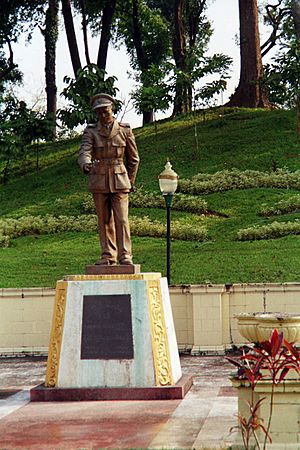
Aung San is highly respected as the person who created modern Burma. He is a national hero for his efforts to gain independence and unite the country.
A Martyrs' Mausoleum was built at the foot of the Shwedagon Pagoda in 1947. July 19 was named Martyrs' Day, a public holiday. Aung San's first mausoleum was destroyed by a blast on October 9, 1983. This happened when the President of South Korea, Chun Doo-hwan, was almost killed by North Korean agents. A new monument was built in its place. Within months of Aung San's assassination, on January 4, 1948, Burma gained independence. By August 1948, a civil war began. It was between the Burmese military and various rebel groups, including communists and ethnic militias. This internal conflict in Myanmar continues today.
Aung San's name has been used by different Burmese governments since independence. However, the military government in the 1990s tried to erase all memories of Aung San. Still, several statues of him are in the former capital, Yangon. His picture is still proudly displayed in many homes and offices across the country. Scott Market, Yangon's most famous market, was renamed Bogyoke Market in his honor. Commissioner Road was renamed Bogyoke Aung San Road after independence. These names are still used. Many other towns and cities in Burma have streets and parks named after him. In the decades after Aung San's assassination, many people saw him as a symbol of democratic change. During the 8888 Uprising in 1988 against the military dictatorship, many protesters carried posters of Aung San. They used them as symbols for their movement. Many people at that time saw Aung San as a symbol of what Burma could have been: prosperous, democratic, and peaceful.
In 1962, the Burmese military, led by Ne Win, overthrew the civilian government. They started military rule. The Burmese military partly justified their government by using Aung San's legacy. He led the country in WWII, being both a military and political leader. After his coup, Ne Win used official statements and propaganda. He promoted the idea that he was Aung San's only true successor. This was because he led the armed forces and was a member of the Thirty Comrades.
Banknotes with Aung San's picture were first made in 1958, ten years after he was killed. This continued until the uprising in 1988. Then, the government replaced his picture with scenes of Burmese life. This was possibly to reduce the popularity of his daughter, Aung San Suu Kyi. In 2017, the Myanmar parliament voted 286–107 to bring back Aung San's image. The new 1,000-kyat notes with Aung San's picture were made and released to the public on January 4, 2020. This date was chosen to mark the 72nd anniversary of Independence Day.
His Family
While he was War Minister in 1942, Aung San met and married Khin Kyi. Around the same time, her sister met and married Thakin Than Tun, the Communist leader. Aung San and Khin Kyi had four children.
After Aung San was assassinated, his wife was appointed Burma's ambassador to India. The family then moved abroad.
Aung San's youngest surviving child, Aung San Suu Kyi, was only two years old when he was killed. She is a Nobel Peace Prize winner. She served as State Counsellor of Myanmar and was the first female Myanmar Minister of Foreign Affairs. She is also the leader of the National League for Democracy (NLD) political party. Aung San's oldest son, Aung San Oo, is an engineer who works in the United States. He has disagreed with his sister's political activities. Aung San's second son, Aung San Lin, died at age eight.
Aung San's wife, Daw Khin Kyi, passed away on December 27, 1988.
Names of Aung San
- Name at birth: Htein Lin (ထိန်လင်း)
- As student leader and a thakin: Aung San (သခင်အောင်ဆန်း)
- Nom de guerre: Bo Teza (ဗိုလ်တေဇ)
- Japanese name: Omoda Monji (面田紋次)
- Resistance period code name: Myo Aung (မျိုးအောင်), U Naung Cho (ဦးနောင်ချို)
- Contact code name with General Ne Win: Ko Set Pe (ကိုဆက်ဖေ)
See Also
 In Spanish: Aung San para niños
In Spanish: Aung San para niños


